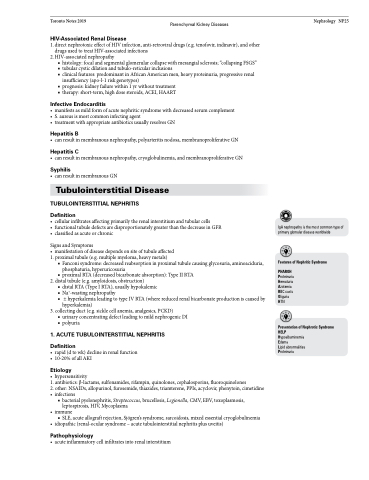Page 725 - TNFlipTest
P. 725
Toronto Notes 2019 Parenchymal Kidney Diseases
HIV-Associated Renal Disease
1. direct nephrotoxic effect of HIV infection, anti-retroviral drugs (e.g. tenofovir, indinavir), and other drugs used to treat HIV-associated infections
2. HIV-associated nephropathy
■ histology: focal and segmental glomerular collapse with mesangial sclerosis; “collapsing FSGS” ■ tubular cystic dilation and tubulo-reticular inclusions
■ clinical features: predominant in African American men, heavy proteinuria, progressive renal
insufficiency (apo-l-1 risk genotypes)
■ prognosis: kidney failure within 1 yr without treatment ■ therapy: short-term, high dose steroids, ACEI, HAART
Infective Endocarditis
• manifestsasmildformofacutenephriticsyndromewithdecreasedserumcomplement • S.aureusismostcommoninfectingagent
• treatmentwithappropriateantibioticsusuallyresolvesGN
Hepatitis B
• canresultinmembranousnephropathy,polyarteritisnodosa,membranoproliferativeGN
Hepatitis C
• canresultinmembranousnephropathy,cryoglobulinemia,andmembranoproliferativeGN
Syphilis
• canresultinmembranousGN
Tubulointerstitial Disease
TUBULOINTERSTITIAL NEPHRITIS
Definition
• cellularinfiltratesaffectingprimarilytherenalinterstitiumandtubularcells
• functionaltubuledefectsaredisproportionatelygreaterthanthedecreaseinGFR • classifiedasacuteorchronic
Signs and Symptoms
• manifestationofdiseasedependsonsiteoftubuleaffected 1. proximal tubule (e.g. multiple myeloma, heavy metals)
■ Fanconi syndrome: decreased reabsorption in proximal tubule causing glycosuria, aminoaciduria, phosphaturia, hyperuricosuria
■ proximal RTA (decreased bicarbonate absorption): Type II RTA 2. distal tubule (e.g. amyloidosis, obstruction)
■ distal RTA (Type I RTA), usually hypokalemic
■ Na+-wasting nephropathy
■ ± hyperkalemia leading to type IV RTA (where reduced renal bicarbonate production is caused by
hyperkalemia)
3. collecting duct (e.g. sickle cell anemia, analgesics, PCKD)
■ urinary concentrating defect leading to mild nephrogenic DI ■ polyuria
1 . ACUTE TUBULOINTERSTITIAL NEPHRITIS Definition
• rapid(dtowk)declineinrenalfunction • 10-20%ofallAKI
Etiology
• hypersensitivity
1. antibiotics: β-lactams, sulfonamides, rifampin, quinolones, cephalosporins, fluoroquinolones
2. other: NSAIDs, allopurinol, furosemide, thiazides, triamterene, PPIs, acyclovir, phenytoin, cimetidine • infections
■ bacterial pyelonephritis, Streptococcus, brucellosis, Legionella, CMV, EBV, toxoplasmosis, leptospirosis, HIV, Mycoplasma
• immune
■ SLE, acute allograft rejection, Sjögren’s syndrome, sarcoidosis, mixed essential cryoglobulinemia
• idiopathic(renal-ocularsyndrome–acutetubulointerstitialnephritisplusuveitis)
Pathophysiology
• acuteinflammatorycellinfiltratesintorenalinterstitium
Nephrology NP25
IgA nephropathy is the most common type of primary glomular disease worldwide
Features of Nephritic Syndrome
PHAROH Proteinuria Hematuria Azotemia RBC casts Oliguria HTN
Presentation of Nephrotic Syndrome HELP
Hypoalbuminemia
Edema
Lipid abnormalities Proteinuria


